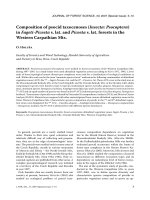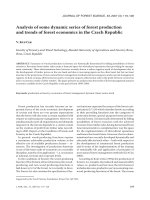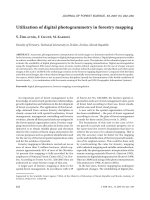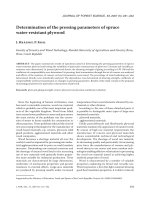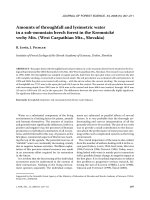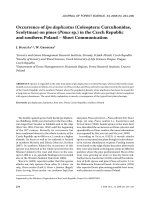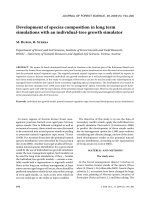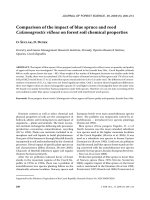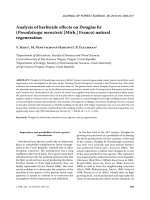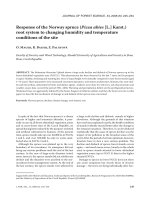Báo cáo lâm nghiệp: "Status of an indigenous agro-forestry system in changing climate: A case study of the middle Himalayan region of Tehri Garhwal, India" potx
Bạn đang xem bản rút gọn của tài liệu. Xem và tải ngay bản đầy đủ của tài liệu tại đây (103.34 KB, 8 trang )
J. FOR. SCI., 56, 2010 (8): 373–380 13
JOURNAL OF FOREST SCIENCE, 56, 2010 (8): 373–380
Status of an indigenous agro-forestry system in changing
climate: A case study of the middle Himalayan region
of Tehri Garhwal, India
C. P. K
Ecosystem and Environment Management, Indian Institute of Forest Management, Nehru
Nagar, Bhopal, India
ABSTRACT: The agro-forestry system is one of the best known indigenous practices for livelihood. In view of instant
decline in the rainfed hill agro-forestry system the present study was undertaken in the hilly villages of Uttarakhand
state of India with the major objective to assess the status and effects of various factors on this centuries old indigenous
agro-forestry system. The survey documented a total of 26 herbaceous food crop species and 21 woody species that
were raised by farmers in the selected villages of Uttarakhand. A total of 37 plant species available in the agro-forestry
system and used for curing various ailments by traditional healers were also documented during the survey. The major
cereals produced by farmers were Oryza sativa L., Echinochloa frumentoacea Link., Eleusine coracana (L.) Gaertner
and Triticum aestivum L. The indigenous system of cropping was locally called as Baranaja that revolved around the
production of > 12 varieties of crops. Besides food, the species grown in the agro-forestry system were used for multi-
ple purposes. Water scarcity, migration of youth in search of employment and changing socio-economic and climatic
conditions were some of the major reasons for declining agro-forestry system and abandoning the agricultural land.
Keywords: Agro-forestry; indigenous practices; climate change; conservation and management; Tehri Garhwal
e majority of indigenous hill agricultural sys-
tems in the Garhwal Himalayan region of India is
operated in the rainfed areas and therefore the on-
set of monsoon is the crucial determinant for the
hill farmers. Historically, the abundant rains dur-
ing summer and rainy seasons helped farmers of
the middle Himalaya to expand their agricultural
practices and grow a variety of cereals and pulses
(S, V 1993; S, J 2001). e
surrounding natural resources and suffi cient agri-
cultural production had simultaneously shaped the
cultural milieu and living style of the local people,
which revolved around the settled agriculture and
animal husbandry (G, S 2005). How-
ever, over a period of time, changing climatic con-
ditions, especially weakening of summer monsoon
and shift in the groundwater level triggered chang-
es in the indigenous agricultural practices. e
groundwater level is estimated to be going down at
a rate of 4 cm per year in northwestern India that
includes the Garhwal Himalayan region (K et
al. 2009). e farmers of this region started diver-
sifying the cropping system, and in order to reduce
the degree of risk and vagaries of climate, many
crop species were sown together. is practice was
traditionally called as ‘Baranaja’ cropping system,
which leads to a symbiosis relationship between
diff erent plants and contributes to increased pro-
ductivity of crops (K 1994; S 1996).
In this indigenously evolved cropping system
of Baranaja, more than 12 varieties of crops were
cultivated together. Further, depending on the dif-
ferent biophysical and environmental set up, some
tree species were also domesticated on the agricul-
tural land, which simultaneously developed the in-
digenous agro-forestry system in the middle Hima-
14 J. FOR. SCI., 56, 2010 (8): 373–380
layan region. Besides, to cope with the monsoon
failure and change in climate, the local people
designed the indigenous agro-forestry system in
such a way so that the livelihood requirement may
be maintained even in the lean periods. Nonethe-
less, in extreme situations, people started migrat-
ing from one place to other for sustaining the bur-
den of survival. Traditionally, the hill farmers have
maintained close linkages and balances between
agriculture, forestry and animal husbandry, and
based on these linkages the land use patterns are
determined in the Garhwal hills (M et al.
2009). Some 20 years ago, about 76% of the hu-
man population was reliant for livelihood on 21%
of land suitable for agriculture in the Garhwal hills
(D et al. 1989). However, several factors
including the continuous shortage of water over
the years have severely impacted the traditional
cropping systems. The historical evidences sug-
gest that availability of water has always become
a main reason for all the major ancient human
civilization to grow and flourish, at the same time,
climate-induced human migration is evident
across the globe including the western and central
Europe, Germany, North American West Coast,
Alaska and Central Andes (G et al. 2006).
Realizing the gravity of ongoing decline in the
centuries old rainfed hill agro-forestry system due
to several reasons including climate change and
scarcity of water, it is imperative to study this once
highly sustained indigenous agro-forestry system.
It is a well known fact that without understanding
the various land use practices adopted by farmers
of the rainfed land, it is diffi cult to achieve the food
security and various livelihood concerns of the lo-
cal people (K 1994; K 2007a,b; K et
al. 2008; K et al. 2009; M et al. 2009).
erefore, the present study aims to understand
and assess the status of the indigenous agro-forest-
ry system in the middle Himalayan region of Tehri
Garhwal of Uttarakhand. Attempts were also made
to study and analyze the various factors, including
climate change responsible for decline in the indig-
enous hill agro-forestry systems.
MATERIAL AND METHODS
Study area
e present study was carried out in the Hisri-
yakhal group of villages of Tehri Garhwal district
in the Uttarakhand state of India. e Uttarakhand
state lies in the northern region of India and spans
over an area of 53,485 km
2
. Of the total 8,479,562
human population of the state, 78% lives in rural
areas. e agriculture land in the hills of Uttara-
khand is scattered and fragmented. e per capita
land holding of Uttarakhand farmers is 0.2 ha, and
about 36% of rural families live below the poverty
line. Agriculture contributes around 37% to state
gross domestic production (M et. al.
2009). e district Tehri Garhwal lies in the hilly
areas of the state and agriculture is the major oc-
cupation of its inhabitants. is district consists of
182 villages with 61,569 ha area under cultivation,
of which irrigated land is only 7.4% (S
2007). Uttarakhand is famous for its biodiversity,
culture, tradition and mythology. e large altitu-
dinal diff erences from the Himalayan foothills to
the high altitude snow laden peaks and subsequent
variations in the climatic and topographical condi-
tions have established and maintained the vegeta-
tion and wildlife of the study area.
Survey methods
Field surveys were undertaken in four villages
of the Hisriyakhal block, namely Chaka, Soudu,
Nausilya and Ghuna located in the Tehri Garhwal
district of Uttarakhand state in India. Semi-struc-
tured questionnaire survey was conducted in the
villages and the head person of the each family
was interviewed for collection of information on
the indigenous system of agro-forestry, which in-
cluded the pattern and production of agriculture
and other crops. In the absence of headperson, the
elder member of the family was interviewed. Infor-
mation was also gathered on the eff ects of chang-
ing climate in terms of declining water availabil-
ity on the indigenous agro-forestry systems. e
indigenous uses of agriculture and forestry spe-
cies were also recorded. e agricultural land was
also surveyed for the availability of agro-forestry
species, their composition and structure. Group
discussion was also conducted with farmers for
understanding the problems and prospects with
the agro-forestry system in the study area along
with the perceptions of local people on the climate
change and indigenous agro-forestry. e informa-
tion was also acquired through fi eld inspections,
fi eld observations, participation in the social life of
local farmers and their cultural events. e avail-
ability status of woody species (tree and shrub) in
the agriculture fi eld was studied by counting the
number of tree individuals in one ha quadrat. A
total of 3 such quadrats were laid down and the
woody species with their individuals were enumer-
ated in each quadrat.
J. FOR. SCI., 56, 2010 (8): 373–380 15
RESULTS AND DISCUSSION
Indigenous agro-forestry structure,
composition, and uses
A total of 26 herbaceous food crop species and
21 woody species raised by farmers in the selected
villages of Uttarakhand were documented during
the present investigations. ere were two promi-
nent cropping seasons – ravi (April–September)
and kharif (October–March) in the study areas. In
ravi season, about 12 varieties of crops were cul-
tivated, which was called Baranaja (local term for
12 varieties of crops). Of these 12 crop species,
5 were cereals, such as Oryza sativa L. (Dhan),
Amaranthus cruentus L. (Chaulai), Echinochloa
frumentoacea Link. (Jhangora), Eleusine coracana
(L.) Gaertner (Maduwa), and Zea mays L. (Mungri)
and 6 were pulses. Echinochloa frumentoacea was
produced in the highest quantity (7,500 per year),
followed by Eleusine coracana and Oryza sativa. Of
the pulses, Macrotyloma unifl orum (Lam.) Verdc.
Table 1. Status of annual crop production in selected villages of Tehri Garhwal
Crops
Production/
family/year
(kg)
Total production village wise (kg)
Tot al
Latin name local name Chaka Soudu Nausilya Ghuna
Cropping season kharif (March–September or summer rainy season)
Main crops
Amaranthus cruentus L. Chaulai 2.00 20 60 10 14.0 104
Oryza sativa L. Satti 50.00 500 1,500 250.0 350.0 2,600
Echinochloa frumentacea Link. Jhangora 150.00 1,500 4,500 750.0 1,050.0 7,800
Eleusine coracana (L.) Gaertner Maduwa 100.00 1,000 3,000 500.0 700.0 5,200
Macrotyloma unifl orum (Lam.)
Verdc.
Gahath 15.00 150 450 75.0 105.0 780
Vigna mungo (L.) Hepper Urd 4.00 40 120 20.0 28.0 208
Phaseolus vulgaris L. Chhemi/rajma 5.00 50 150 25.0 35.0 260
Cajanus cajan (L.) Millsp. Tor 5.00 50 150 25.0 35.0 260
Sesamum orientale L. Til 2.00 20 60 10.0 14.0 104
Vigna unguiculata (L.) Walp. Sonta 0.50 5 15 2.5 3.5 26
Raphanus sativus L. Mula 5.00 50 150 25.0 35.0 260
Zea mays L. Mungri 2.50 25 75 12.5 17.5 130
Vegetables
Cucurbita maxima Duch. ex Lam. Kadu 50.00 500 1,500 250.0 350.0 2,600
Lagenaria siceraria Standl. Launki 25.00 250 750 125.0 150.0 1,275
Tricosanthes anguina L. Chachenda 5.00 50 150 25.0 35.0 260
Momordica charantia L. Karela 10.00 100 300 50.0 70.0 520
Brassica rugosa (Roxb.) Bailey Rai 5.00 50 150 25.0 35.0 260
Spinacea oleracea L. Palak 5.00 50 150 25.0 35.0 260
Colocasia himalayensis Pindalu 10.00 100 300 50.0 70.0 520
Momordica dioica Roxb. ex Willd. Kankora 5.00 50 150 25.0 35.0 260
Cropping season ravi (October–March or winter season)
Triticum aestivum L. Gehun 35.00 350 1,050 175.0 245.0 1,820
Hordium vulgare L. Jau 10.00 100 300 50.0 70.0 520
Lens esculenta Moench. Masur 6.00 60 180 30.0 42.0 312
Pisum sativum L. Matar 0.50 5 15 2.5 3.5 26
Solanum tuberosum L. Alu 10.00 100 300 50.0 70.0 520
Brassica campestris L. Sarson 5.00 50 150 25.0 35.0 260
16 J. FOR. SCI., 56, 2010 (8): 373–380
(Gahath) produced the highest yield, followed by
Phaseolus vulgaris L. (Chhemi) and Cajanus cajan
(L.) Millsp. (Tor). Apart from this, 8 varieties of veg-
etables were also cultivated by farmers during April
to September: of these Cucurbita maxima Duch. ex
Lam. (Kadu) was produced in the highest quantity,
followed by Lagenaria siceraria Standl. (Launki). In
the kharif season, a total of 6 crops were cultivated
by the farmers, of these 3 were cereals and 3 were
pulses and vegetables. Triticum aestivum L. (Ge-
hun) was the major cereal, and farmers produced
about 1,850 per year, with average production of
35 per family (Table 1).
e major woody species grown by the farmers in
their agro-forestry system were Celtris australis L.
(Khadik), Melia azedarach L. (Daikan), Grevia op-
tiva Dumm. ex Burret. (Bhimal), Pinus roxburghii
Sarg. (Kulai) and Toona serrata (Royle) M. Roemer
(Tun). e forestry species served for multiple in-
digenous uses including fodder, fuelwood, fi bres,
timber, medicine and food. Some of the species
were also used for religious purposes. e seeds of
Pinus roxburghii (chir pine) were also gathered to
eat. Besides, two species were used as bio-fencing
(Table 2). e fodder trees such as Melia azedarach,
Celtris australis and Grevia optiva were planted on
the agricultural land as well as within the village
premises. During the scarcity of fodder in the sum-
mer season these fodder tree species were lopped to
feed cattle, especially milking animals. e fodder
trees are planted at the bunds of the land. Among
all the tree species, Grevia optiva was the most im-
portant multipurpose species that once planted on
the terrace bunds regenerated naturally. e seed-
lings were then protected by farmers. Apart from
fuelwood, fi bre, fodder and medicine, the bark and
stem of Grevia optiva were used to make baskets.
Some of the crops such as Cleome viscosa L. (Jak-
khya) were not cultivated and although growing as
weeds on the agricultural land it was interestingly an
important cash crop. Generally, it was weeded out
from the agricultural crops, and only a few individu-
als were left to grow with the crops. A single individ-
ual of jakkhya might have produced 50–100 g seeds
Table 2. Status of tree species in the agro-forestry system of selected villages of Tehri Garhwal
Latin name Local name No. of individuals·ha
–1
Major ethno-botanical uses
Trees
Grevia optiva Dumm. ex Burret. Bhimal 34 fodder, fi bre, fuel
Pyrus pashia Buch Ham. Melu 42 fruit – edible
Prunus persica (L.) Batsch Aru 11 fruit – edible
Celtris australis L. Khadik 23 fodder
Sapium insigne Royle Khinna 2
Pinus roxburghii Sarg. Chir 1 timber, fuelwood
Bombax ceiba L. Semal 2 fl ower – vegetable
Toona serrata (Royle) M. Roemer Tun 1 timber
Prunus cerasoides D. Don Paiyan 5 religious
Mangifera indica L. Aam 1 fruit – edible
Punica granatum L. Anar 1
fruit – edible; fruit cover
– medicine for cough & cold
Melia azedarach L. Daikan 2 fodder; timber
Ficus semicordata Buch Ham. ex Smith Khainu 2 fruit – edible
Ficus auriculata Lour. Timla 1 fruit – edible
Shrub
Berberis asiatica Roxb. ex DC. Kingod 26 root – medicine; fruit – edible
Rhus parvifl ora Roxb. Shaunlu 10 stem – toothpaste; fruit – edible
Rubus ellipticus Smith Hisar 22 fruit – edible
Ficus palmata Forsk. Bedu 16 fruit – edible
Carissa opeca Stapf. Karonda 20 fruit – edible
Vitex negundo L. Shiwali 3 bio-fencing, medicinal
Euphorbia royleana Bioss. Sullu 4 bio-fencing
J. FOR. SCI., 56, 2010 (8): 373–380 17
depending on the soil, water and farm yard manure
conditions. e major use of Jakkhya was to fl avour
diff erent dishes made up of pulses and vegetables.
Jakkhya was sold at the rate of Rs. 12/– per kg. Be-
cause of trade and changing climatic conditions it
has been reduced over the years. e other reason
of low production of Jakkhya was the continuous
reduction of manure in the fi eld.
Many of these species growing in the agro-for-
estry system were used by local people and in most
cases by some specialized traditional herbal heal-
ers for curing various types of diseases prevalent in
the study villages. e present survey documented
37 plant species growing in the agro-forestry sys-
tem and used by traditional healers for curing mul-
tiple diseases. Of these medicinal plants, 11 were
tree species, 7 shrubs and 19 were herbaceous spe-
cies (Table 3). Diff erent plant parts of these spe-
cies, such as bark, root, leaf, stem, fl ower and seed
were used for medicine preparation. In general, the
traditional agro-forestry system in the study vil-
lages was raised and nurtured in such a way that
the basic requirement of living for food, shelter and
medicine might have been achieved.
Traditional ecological knowledge
and management of agro-forestry
Only few species of trees were planted on the agri-
cultural land by the farmers. By growing only a few
species of trees the farmers reduced the risk of crop
competition with trees. It is a known fact that once
the tree is established, its underground parts go
deeper in the soil than the agricultural crops, which
also helps in diminishing competition for nutrients
and soil moisture. e increase in competition be-
tween trees and agricultural crops may reduce the
crops yield. ere are reports on minimum number
and maximum yield strategy adopted by farmers
elsewhere in the world to diversify land use in agro-
forestry systems (Z 2008). e farmers of the
study villages kept on lopping and thinning trees
in the agro-forestry system, which maintained the
space and provided a critical factor for the survival
of crops, the sun light. A study conducted elsewhere
has pointed out that the wood quality gets improved
by pruning or cutting of branches. Besides, it also
helps to grow trees taller (Z 2008).
Each village ecosystem in the study area was
mainly revolved around the practices associated
with agriculture, forestry and animal husbandry.
e villagers had developed interrelationships and
linkages between these practices in such a way that
the existing resources may be optimally utilized for
maintaining the continuity of the system. In the pe-
riod between harvesting one crop and sowing an-
other crop, the domestic animals were freed on the
land used for agriculture. is helped to supply ma-
nure and maintained the fertility of land. e entire
agro-forestry system was purely organic and cattle
dung was used to increase the fertility of land. Each
family in the study villages had about 0.8 ha of land
under the agro-forestry system. Accordingly, all
52 families of the 4 study villages had about 42 ha
of land under agroforesty that was treated annually
by about 400 quintals of cow dung as farm yard ma-
nure. A part of the cattle dung was also used as fuel
by sun drying. e agriculture land was surrounded
by scattered chir pine (Pinus roxburghii Sarg.) trees
and the understory in these thin forests was grazed
and browsed by domestic animals. Due to the alti-
tudinal gradients, the cattle dung in these pine for-
ests with other organic matter drained down in the
agricultural fi eld and subsequently increased the
fertility of the land.
One of the important aspects of the traditional
agro-forestry system was to produce fodder for
livestock. After thrashing crops to grains, the resi-
due or hey was used for feeding cattle during the
lean period. e dry crop residue and grasses were
piled and stored around homestead trees for the
use by cattle during the lean period. is storage
of dry grasses and crop residue was locally called
‘Parkhunda’. In the case of fodder adequacy to cat-
tle, some of the crop residue was scattered on the
agricultural land for improving the fertility of soil.
e farmers were also very particular for seeds used
to raise next year’s crops. To protect such seeds
from fungus infection and pests, the farmers used
to treat them with cow urine, ash, and Azadirachta
indica (A. Juss) Callus (locally called as Neem) leaf
and stored it in a separate box made up of wood or
bamboo. After separating grains the stems of wheat
plants were used to prepare carpets and baskets.
Such baskets made of wheat stems were also used
to store grains.
Changing climate and eff ects on agro-forestry
system
Water scarcity was a common problem of all the
villages in the study area. e water quantity has
either decreased several times or the water sources
have completely dried up in the area over the years.
It was hard to get even drinking water. Due to
scarcity of water people were forced to drink dirty
polluted water stored for several days, which was
very unhygienic. During summer, the villagers were
18 J. FOR. SCI., 56, 2010 (8): 373–380
Table 3. Various crops and other plant species used by specialized traditional herbal healers for curing diseases in
the study villages
Latin name Family Local name Plant used Medicinal uses Life form
Pyrus pashia Buch Ham. Rosaceae Melu fr digestive disorder shrub
Prunus persica (L.) Batsch Rosaceae Aru lf, bk
cold and cough, suppressed
urination
tree
Grevia optiva Dumm. ex Burret. Tiliaceae Bhimal lf, fr, st
bone fracture, child birth,
fever
tree
Lagenaria siceraria Standl. Cucurbitaceae Lauki fr, lf jaundice, cracks herb
Bombax ceiba L. Bombacaceae Semel rt, bk
blood dysentery, asthma,
dysentery, fever
tree
Celtis australis L. Ulmaceae Khadik bk leprosy tree
Cleome viscosa L. Cleomaceae Jakkya sd, lf rheumatic arthritis, wounds herb
Colocasia esculenta (L.) Schott Araceae Pindalu tuber indigestion herb
Cucurbita maxima Duch. ex Lam. Cucurbitaceae Kaddu sd, fr intestinal worms herb
Curcuma domestica Valeton Zingiberaceae Haldi rh
skin and digestive disorder,
blood purifi cation
herb
Euphorbia royleana Boissier Euphorbiaceae Sullu latex antiseptic shrub
Hordeum vulgare L. Poaceae Jau sd pimples, urinary complaints herb
Lens esculenta Moench. Fabaceae Masur sd skin diseases herb
Mangifera indica L. Anacardiaceae Aam sd, bk
diarrhoea, haemorrhage,
scabies, tonic
tree
Carissa opeca Stapf. Apocynaceae Karonda lf, rt, bk fever, purgative shrub
Cajanus cajan (L.) Millsp. Fabaceae Tor sd, lf, fl skin burn, mouth sores herb
Brassica compestris L. Brassicaceae Sarson wp migraine, cough, leprosy herb
Brassica rugosa (Roxb.) Bailey Brassicaceae Pahari rai sd body-ache, skin diseases, cold herb
Berberis aristata DC. Berberidaceae Kingode rt, bk fever, eye complaints shrub
Amaranthus spinosus L. Amaranthaceae Chaulai wp
blood purifi cation, cold,
cough, snake bite
herb
Ficus auriculata Lour. Moraceae Timla fr digestive disorder tree
Ficus palmata Forsk. Moraceae Bedu fr digestive disorder tree
Ficus semicordata Buch Ham.
ex Smith
Moraceae Khaina fr digestive disorder tree
Melia azedarach L. Meliaceae Daikan fr, lf
antiseptic, abortifacient, rheu-
matic pain
tree
Momordica charantia L. Cucurbitaceae Karela lf, sd, fr, rt diabetes, eczema, malaria herb
Momordica dioica Roxb. ex Willd. Cucurbitaceae Kankora wp
asthma, piles, headache,
delirium
herb
Pisum sativum L. Fabaceae Matar sd diabetes herb
Psidium guajava L. Myrtaceae Amrood bk, lf throat infection, diarrhoea tree
Raphanus sativus L. Brassicaceae Muli, mula lf, sd fever, liver disorder, bronchitis herb
Rhus parvifl ora Roxb. Anacardiaceae Saunla, Tungla lf cholera shrub
Rubus ellipticus Smith Rosaceae Hinsalu rt, fr
dysentery, malaria,
stomach-ache
shrub
Sesamum orientale L. Pedaliaceae Til sd
aphrodisiac, body-ache,
dysmenorrhoea
herb
Solanum tuberosum L. Solanaceae Aalu tuber burns, skin irritations herb
Spinacea oleracea L. Chenopodiaceae Palak lf kidney stones herb
Toona ciliata Roem. Meliaceae Tun bk, fr, lf
antiseptic, bronchitis, fever,
dysentery
tree
Vigna mungo (L.) Hepper Fabaceae Urd sd indigestion herb
Vitex negundo L. Verbenaceae Shiwali st, fl , lf arthritis, sprains shrub
lf – Leaf; sd – seed; fr – fruit; fl – fl ower; bk – bark; wp – whole plant; st – stem; rh – rhizome
J. FOR. SCI., 56, 2010 (8): 373–380 19
mainly dependent on the water supplied by tank-
ers. But it was diffi cult to supply even the drinking
water to the villagers away from the roadside. All
the villagers unanimously admitted that the fer-
tility of land had decreased over the years due to
scarcity of water and climate change. In the past
couple of years, the rainfall was highly unpredict-
able, and generally, it was low, which led to the low
productivity.
e area of agro-forestry land has been reduced
due to several reasons including the migration of
people in search of quality life standards. It was no-
ticed that most of the present agro-forestry tech-
niques as practiced by farmers were poorly man-
aged and in the majority of cases, the trees were
neither protected nor replanted. Similar obser-
vations were made by D et al. (1989). In
some cases, the use of chemical fertilizers on the
rainfed agricultural land by some farmers of the
nearby district led to dry up the indigenous agro-
forestry system. e use of chemical fertilizers and
pesticides on the rainfed land is not considered
suitable for the production of crops in the long run
and also negatively aff ects the agro-ecosystem and
surrounding biodiversity (K 2007b). Recently
in June 2009, there was a report on sudden death of
10,000 parakeets in the nearby district of Garhwal
– Udham Singh Nagar, which was associated with
the use of pesticides on the farmlands.
Earlier, farmers had alternative ways of cropping,
changing the crop sown to varieties that needed
only a few showers to mature, like millet. But cur-
rently due to years of stress migration, people were
losing the will and the indigenous knowledge to in-
vest in rainfed agriculture. Due to instant shrink-
ing of the agro-forestry land area, the available
standing crops were repeatedly destroyed by wild
animals such as wild boar, monkey and porcupine.
Since a major part of the agricultural land has been
now left barren, the concentration of damage by
wild animals increased on the available land under
agro-forestry system.
Within the past less than a decade, some of the
crops cultivated previously have become locally
extinct from the study villages. Setaria italica (L.)
Beauv. (Koni) was such a crop, which was no more
cultivated now but 10 years ago each family had
produced about 10 kg Setaria italica per year. It
was matured 15–20 days before Echinochloa fru-
mentacea and was one of the important crops of the
Baranaja system of Garhwal. e dishes prepared
from Setaria italica had a high nutritive value. Be-
sides, Sorghum vulgare Pers. (locally called Jund-
la) was also cultivated by the villagers in the past,
about 2 decades ago, but now its cultivation was
also stopped. ere were diff erent landraces of rice
and two of them were the major landraces – red-
dish and white seeds. Generally, the red landrace of
rice was cultivated by the farmers as it had several
advantages including the high nutritive value. It
was also less damaged by wild animals such as wild
boar due to its spiny grains, which were unpalata-
ble and uncomfortable to eat. e landraces are the
product of continuous selection, breeding, experi-
mentation and on-farm conservation of mountain
farmers, and local extinction of these landraces is
the cause of concerns to continue the traditional
Baranaja system of mixed cropping.
An indigenous agro-forestry system not only sup-
ports the livelihood through production of food,
fodder and fi rewood but also mitigates the impact of
climate change through carbon sequestration (P-
2002, 2007). In the agro-forestry system, the
soil is enriched through continuous biomass fl ow
(bedding material in the animal sheds, fodder and
mulch material, for example) from the surrounding
forest areas (G, S 2005). e system of
tree growing in combination with agriculture needs
to be maintained, especially in the hills with an im-
portant view of maintaining the land stability and
protection from soil erosion. For sustained develop-
ment in the region it is important to continue or-
ganic farming for enriching soil and soil depth. Be-
ing a centuries old locally adaptive system, it is one
of the promising areas of land use. e indigenous
knowledge developed over the centuries by the hill
farmers on the variability of sowing and harvest-
ing of crops at various elevations is an example of
mitigating the impact of changing climate. e agri-
cultural crops are supported by trees on the rainfed
land, which receives low rainfall, by retaining the
moisture content in the soil and atmosphere.
Since the 1970s the total cropped area in India
has remained static at around 140 million, and ac-
cording to the National Agricultural Policy, India
must achieve a growth rate of 3–4% per annum in
the sector. e shrinking agro-forestry system in
the hills of Uttarakhand may enhance the problem
of meeting the country’s requirement for food se-
curity. e National Agricultural Policy should in-
clude and address the core issue of hill agriculture,
which is mostly organic and rich with indigenous
crops diversity, for its continuity. Besides, the agro-
forestry system sequesters a sizeable amount of
carbon and helps in mitigating the global climate
change. Hence, it is important to encourage the
farmers for continuing the tradition of agro-for-
estry. e hill topography, soil ecosystem, land
20 J. FOR. SCI., 56, 2010 (8): 373–380
fragility and environmental heterogeneity may not
substantiate mono-cropping, hence the Baranaja
system of mixed cropping should be continued.
Acknowledgements
e author thanks the Director, Indian Institute
of Forest Management, India for help and sup-
port. e help provided by the villagers of T
G during the fi eld survey, especially B-
B, S and A R, is
greatly acknowledged.
References
D K.S., N P., D S.K. (1989): Agroforestry
systems in the Garhwal Himalayas of India. Agroforestry
Systems, 7: 213–225.
G P.L., S V. (2005): A framework for sustainable
food security. In: D M.L., B J. (eds): Uttaran-
chal: Vision and Action Programme. New Delhi, Concept
Publishing Company: 67–81.
G A.K., A D.M., P D.N., S A.K.
(2006): Adaptation and human migration, and evidence
of agriculture coincident with changes in the Indian sum-
mer monsoon during the Holocene. Current Science, 90:
1082–1090.
K C.P. (2007a): Local preferences of ethnobotanical spe-
cies in the Indian Himalaya: Implications for environmental
conservation. Current Science, 93: 1828–1834.
K C.P. (2007b): Prioritization of cultivated and wild edibles
by local people in the Uttaranchal hills of Indian Himalaya.
Indian Journal of Traditional Knowledge, 6: 239–243.
K C.P., D M., F N.A., C D.C.
(2008): Land-use management and wet-rice cultivation (Jebi
Aji) by the Apatani people in Arunachal Pradesh, India. Out-
look on Agriculture, 37: 125–130.
K R., G A., B A. (2009): A home grown
drought. Down to Earth, 18(8): 1–8. Available at http://
www.downtoearth.org.in/fullprint.asp (accessed on Oc-
tober 9, 2009).
K A. (1994): Reviving diversity in India’s agriculture.
Seedling, 14: 1–4. Available at />ling/index.cfm?id=393 (accessed on July 23, 2009).
M R.K., R L.S., P P.C., N V.S.,
F N.A., N C. (2009): Hill agriculture of Ut-
tarakhand: Policy, governance, research issues and devel-
opment priorities for sustainability. e India Economy
Review, 6: 116–123.
P D.N. (2002): Global climate change and carbon
management in multifunctional forests. Current Science,
83: 593–602.
P D.N. (2007): Multifunctional agroforestry systems
in India. Current Science, 92: 455–463.
S V. (1996): Towards a biodiversity based productivity
framework. ILEIA Newsletter, 12: 22–24.
S V., V R.P. (1993): Cultivating Diversity: Biodi-
versity Conservation and Seed Politics. Research founda-
tion for Science Technology and Natural Resource Policy.
Dehradun, Natraj Publishers: 130.
S V., J V. (2001): Landrace renaissance in the
mountains: Experiences of the Beej Bachao Andolan in
the Garhwal Himalayan region, India. In: Proceedings
International Symposium on Participatory Plant Breeding
and Participatory Plant Genetic Resources Enhancement,
Cali, Columbia. IDRC 87–96.
S A.K. (2007): Enhancement of livelihood security
through sustainable farming systems and related farm
enterprises in North-West Himalaya. [Project Report.]
Almora, Vivekananda Parvatiya Krishi Anusandhan San-
sthan: 16
Z B. (2008): e science of forestry. Journal of Sustain-
able Forestry, 27: 345–473.
Received for publication November 30, 2009
Accepted after corrections February 19, 2010
Corresponding author:
Ph.D. C P K, Indian Institute of Forest Management, Ecosystem & Environment Management,
P.B. No. 357, Nehru Nagar, Bhopal - 462 003, Madhya Pradesh, India
tel.: + 91 755 277 54 61, fax: + 91 755 277 28 78, e-mail: ;
